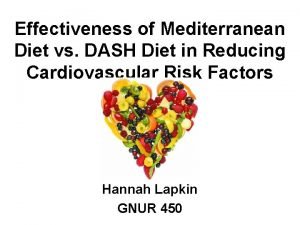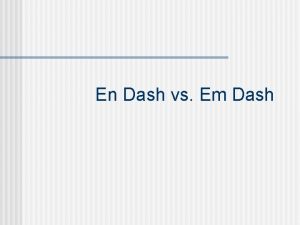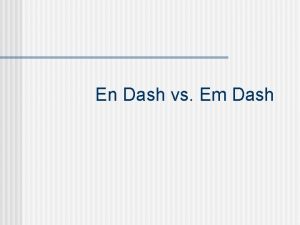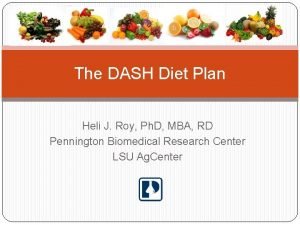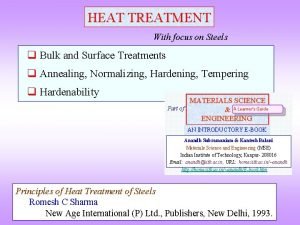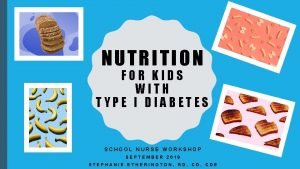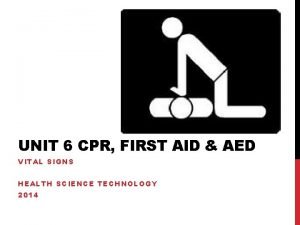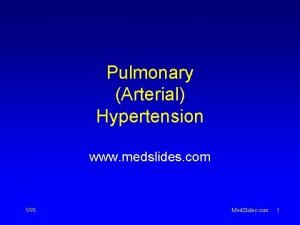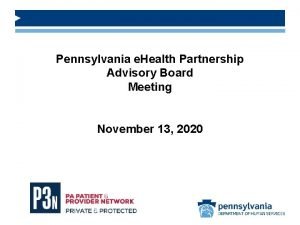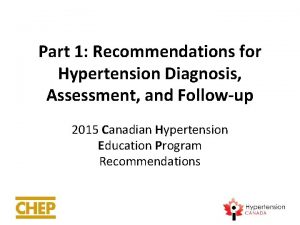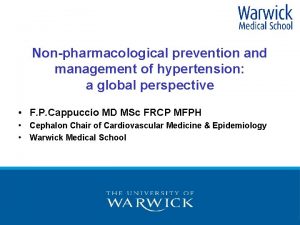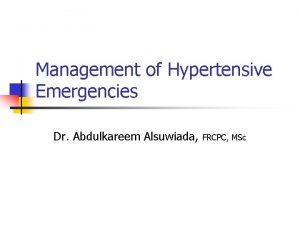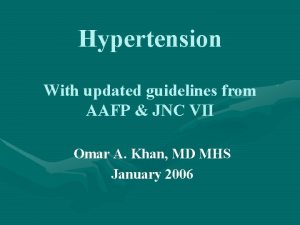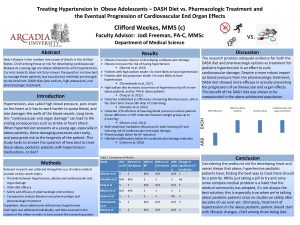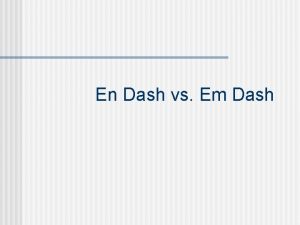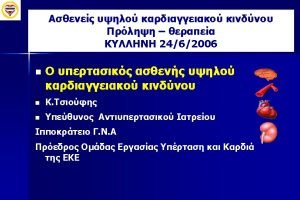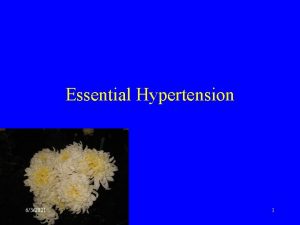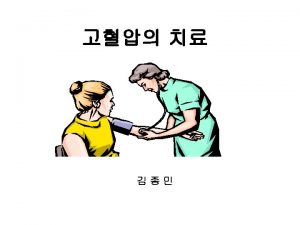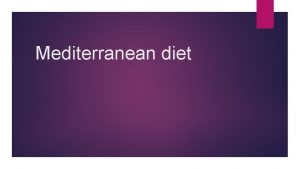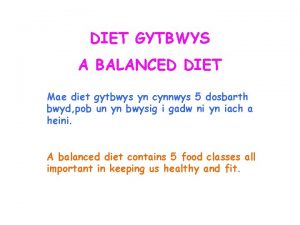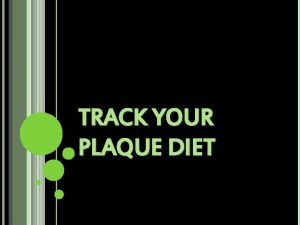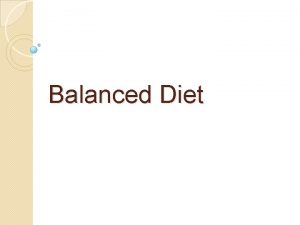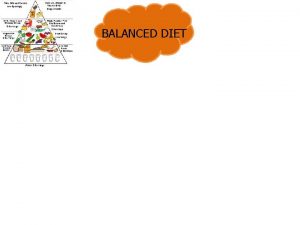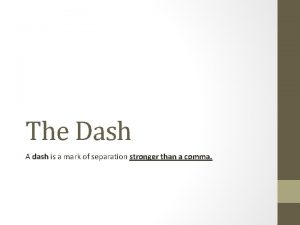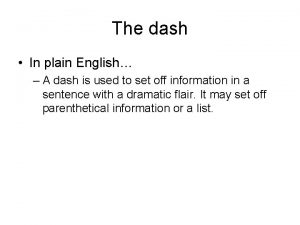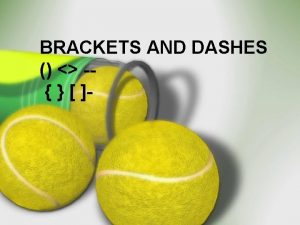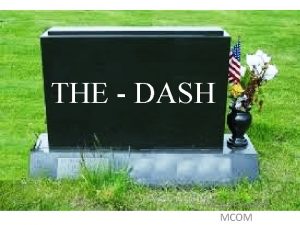The DASH Diet in treating Hypertension Type 2


























- Slides: 26

The DASH Diet in treating Hypertension & Type 2 Diabetes Kathleen T. Morgan Chair, Family & Community Health Sciences Special Thanks to Colorado State Univ and Western Dairy Council

Hypertension & Type 2 Diabetes • 72 million people in the US age 20 and older have high blood pressure • 20. 8 million – 7 % of the US population have diabetes • 13. 3 % of all non-Hispanic blacks aged 20 and older have diabetes • After adjusting for population age differences, Mexican Americans, the largest Hispanic/Latino subgroup, are 1. 7 times as likely to have diabetes as non-Hispanic whites.

Hypertension & Type 2 Diabetes • The prevalence of hypertension is about twice as high among patients diagnosed with type 2 diabetes as it is among patients without diabetes • The current obesity epidemic contributes to hypertension and type 2 diabetes • Losing as little as 10 pounds can contribute to reducing hypertension and improving glucose sensitivity.

Diabetes & HTN & Disparities • African American men develop diabetes and high blood pressure earlier in life than other men and are more likely to suffer serious side-effects from these diseases • Within the African-American community, those with the highest rates of hypertension, are likely to be middle aged or older, less educated, overweight or obese, physically inactive and to have diabetes

Diabetes & HTN & Disparities • Remediable factors: – Worse access to high-quality healthcare – Socioeconomic barriers to buying healthy food and necessary medications – Lack of culturally appropriate care

Dietary Approaches to High Blood Pressure • DASH Diet – Dietary Approaches to Stop Hypertension – Promotes fruits, vegetables, whole grains and low fat dairy products – Adequate Calcium, Potassium, Magnesium – Low in red meat, sweets and sugar beverages

Hypertension Prevalence • 50 million hypertensive US adults • One-third of people are unaware • Less than half of American adults have optimal blood pressure • Increases in prevalence and severity in African Americans

Blood Pressure Categories - Adults Systolic (mm Hg) Diastolic (mm Hg) Optimal <120 and <80 Normal <130 and <85 130 -139 or 85 -90 140 -159 or 160 -179 or >180 or 90 -99 100 -109 >110 High-Normal High Stage 1 Stage 2 Stage 3

Untreated Hypertension Target Organ Damage Includes: • Hypertensive heart disease • Cerebrovascular disease • Renal disease • Large vessel disease

Public Health Challenge of Hypertension • Prevent BP rise with age • Decrease existing prevalence – Healthy People 2010 goal – 16% • Increase awareness and detection – Has no symptoms, called the “silent killer” • Improve control • Reduce cardiovascular risks • Increase recognition of importance of controlling systolic hypertension

National High Blood Pressure Education Program Updated Recommendations to Prevent Hypertension • Maintain normal body weight for adults – BMI 18. 5 -24. 9 kg/m 2 • Reduce sodium intake to no more than 100 mmol/day • Regular physical activity – at least 30 minutes most days of the week • Limit alcohol consumption • Maintain adequate potassium intake • Consume a diet rich in fruits, vegetables and low-fat dairy products • Reduce saturated fat and total fat in diet JAMA, Oct 16, 2002

Mineral Intake and Hypertension Calcium • American Heart Association Statement – Increasing calcium intake may preferentially lower blood pressure in salt-sensitive people – Benefits more evident with low initial calcium intakes (300 -600 mg/day)

Mineral Intake and Hypertension Potassium • Clinical trials and meta-analyses indicate potassium (K) supplementation lowers BP • Adequate K intake, preferably from food sources, should be maintained • Evidence is strong enough to support a health claim on high potassium foods

Mineral Intake and Hypertension Magnesium • Evidence suggests an association between lower dietary magnesium intake and high blood pressure • Not enough evidence exists to justify a recommendation of increased Mg intake

DASH is Unique • Tested dietary patterns rather than single nutrients • Experimental diets used common foods that can be incorporated into recommendations for the public • Investigators planned the DASH diet to be fully compatible with dietary recommendations for reducing risk of CVD, osteoporosis and cancer

DASH Reduces Homocysteine Levels • Effect a result of diet high in vitamin B-rich milk and milk products, fruits and vegetables • Lowering homocysteine with DASH may reduce CVD risk an additional 7%-9% -Appel, et al. Circulation, 102: 852, 2000

DASH Diet Pattern based on a 2, 000 calorie diet Food Group Grains Vegetables Fruits Low-fat or fat free dairy Meats, poultry, fish Nuts, seeds, dry beans and peas Fats and oils Sweets Servings* 7 -8 4 -5 2 -3 less than 2 4 -5/week 2 -3 5/ week

DASH: Dietary Recommendations DASH meets multiple dietary recommendations • NIH-NHLBI-ATP III • AHA • USDA/DHHS Dietary Guidelines • NCI and AICR • Surgeon General Recommendations

Dietary recommendations includes Therapeutic Lifestyle Changes (TLC) • • • Saturated fat: 7% of total calories Cholesterol: < 200 mg/day Weight reduction Increased physical activity Viscous (soluble) fiber: 10 -25 g/day Plant stanols/sterols: 2 g/day

Take Time for Some TLC • Choose foods low in saturated fat – Whole grains – Fruits – Vegetables – Fat free or 1% dairy products – Lean meats, fish, skinless poultry – Dried peas/beans

Take Time for Some TLC (cont) • Choose foods low in cholesterol – Plant-based foods • Grains • Fruits • Vegetables • Dried beans

Easily implemented suggestions: • Make connections between dietary practices and health concerns very concrete, address options for reducing sodium • De-emphasize the “low-income” designation of the audience for whom the program is intended • Encourage participants to attend classes in “teams” to support each other • Emphasize food demonstrations • Encourage participants to visit supermarkets, read labels or conduct an informal survey of friends or family




Rutgers Cooperative Extension Programs • Encourage participation in Rutgers Essex County’s Cooperative Extension’s: – Food Stamp Nutrition Education Program (FSNEP) – Expanded Food and Nutrition Education Program (EFNEP) –Thank you –Morgan@rce. rutgers. edu
 Dash diet vs mediterranean diet
Dash diet vs mediterranean diet En dash vs em dash
En dash vs em dash Em dash examples in sentences
Em dash examples in sentences Dash diet pyramid
Dash diet pyramid Conclusion of hypertension
Conclusion of hypertension Dash diet definition
Dash diet definition Chapter 24 lesson 2 preventing and treating stds
Chapter 24 lesson 2 preventing and treating stds Tumor treating fields mechanism of action
Tumor treating fields mechanism of action Cognitive approach to treating depression
Cognitive approach to treating depression Ethical issues in treating lgbt patients
Ethical issues in treating lgbt patients Mowrer's two process model
Mowrer's two process model Treating customers fairly training
Treating customers fairly training Wholesale hardening and tempering
Wholesale hardening and tempering Chapter 4 ethics and social responsibility
Chapter 4 ethics and social responsibility Blood type diet definition
Blood type diet definition Diabetic exchange list
Diabetic exchange list Diueritique
Diueritique Hypertension vs hypotension
Hypertension vs hypotension Hypertension
Hypertension Jnc 7 hypertension
Jnc 7 hypertension Syndrome méningé
Syndrome méningé Pah vs pulmonary hypertension
Pah vs pulmonary hypertension Hypertension
Hypertension Diagnosis hypertension
Diagnosis hypertension Non pharmacological management of hypertension
Non pharmacological management of hypertension Hypertensive emergency vs urgency
Hypertensive emergency vs urgency Demadex
Demadex
